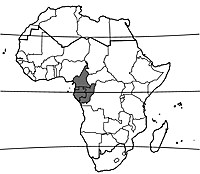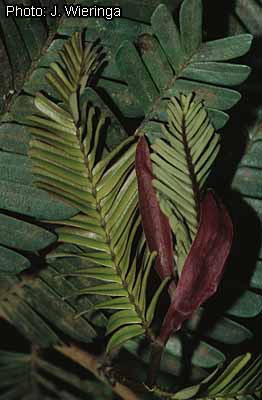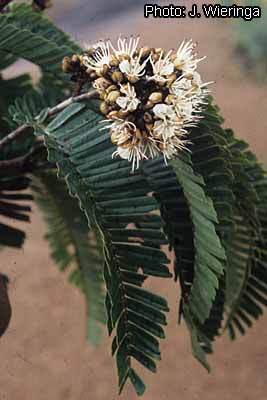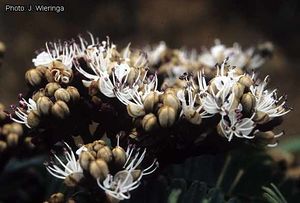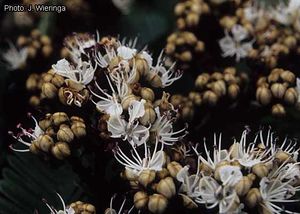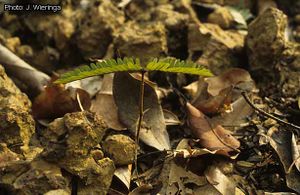Introduction |
Bikinia le-testui (Pellegr.) Wieringa
- Protologue: Wageningen Agric. Univ. Pap. 99(4): 222 (1999).
- Family: Caesalpiniaceae (Leguminosae - Caesalpinioideae)
Synonyms
- Monopetalanthus le-testui Pellegr. (1942).
Vernacular names
- Andoung de Le Testu (Fr).
Origin and geographic distribution
Bikinia le-testui occurs in western Cameroon, Equatorial Guinea, Gabon and south-western Congo.
Uses
The wood, traded from Cameroon as ‘ekop’ or ‘mayo’ and from Gabon as ‘andoung’ together with other Bikinia spp., Aphanocalyx spp. and some other Caesalpiniaceae, is used for light construction, joinery, furniture, vehicle bodies, ladders, sporting goods, toys, novelties, tool handles, boxes, crates, matches, veneer, plywood and pulpwood. It is also suitable for light flooring, interior trim, ship building and railway sleepers.
Production and international trade
Bikinia le-testui timber is exported from Cameroon in small quantities, mixed with the timber of other species classified as ‘ekop’ or ‘mayo’, but statistics are not available. The export of ‘andoung’ logs from Gabon increased from 2700 m³ in 1991 to 47,000 m³ in 1999 and then decreased to 10,300 m³ in 2009. The contribution of Bikinia le-testui was probably moderate because this species is usually not found in large numbers in Gabon. The export from Cameroon was 3600 m³ in 2009.
Properties
The heartwood is pale pinkish brown to pale brown, darkening upon exposure to reddish brown, and not distinctly demarcated from the up to 12 cm wide sapwood. The grain is usually interlocked, texture moderately fine and even.
The wood is medium-weight, with a density of 550–750 kg/m³ at 12% moisture content, and rather soft to moderately hard. It air dries fairly well with little degrade when proper care is taken; slow drying is recommended, especially in kiln drying. The rates of shrinkage are moderate to rather high, from green to oven dry 3.5–6.0% radial and 7.8–11.5% tangential. Once dry, the wood is only moderately stable in service.
At 12% moisture content, the modulus of rupture is 101–170 N/mm², modulus of elasticity 9500–13,340 N/mm², compression parallel to grain 41–56 N/mm², shear 4.5–9.5 N/mm², cleavage 11–28 N/mm and Chalais-Meudon side hardness 2.0–4.1.
The wood saws and works well with both machine and hand tools. In planing operations woolly surfaces may occur due to the interlocked grain; cutting edges should be kept sharp and a cutting angle of 15° is recommended. The wood takes a nice polish upon finishing. It holds screws and nails well. Gluing properties are good and the wood takes paint, varnish and wax well. Boring, slicing and peeling characteristics are good. The results of rotary peeling are usually satisfactory for fresh logs, but for logs of about 60 cm in diameter steaming at 80°C is recommended. The quality of the resulting veneer may be influenced by exudate production and rough surfaces because of interlocked grain. Careful drying of the veneer is needed to avoid splitting and deformation. The wood is moderately durable, being susceptible to fungal and insect attacks. The heartwood is resistant to impregnation with preservatives, but the sapwood is permeable.
The wood contains 44–48% cellulose, 27–28% lignin, 16.5–19.5% pentosan, 0.5–0.7% ash and traces of silica. The solubility is 2.7–6.3% in alcohol-benzene, 1.2–1.7% in hot water and 12.7–14.4% in a 1% NaOH solution.
Description
- Large tree up to 55 m tall; bole straight, cylindrical, branchless for up to 30 m, up to 200(–260) cm in diameter, with buttresses up to 2 m high; bark surface smooth to slightly rough, greyish red to reddish brown with reddish lenticels, inner bark fibrous, yellow to yellowish brown; crown hemispherical; twigs greyish brown to greyish green with brown lenticels, glabrous to slightly hairy.
- Leaves arranged spirally, paripinnately compound with (9–)13–24(–28) pairs of leaflets; stipules free, ovate to obovate, up to 5.5 cm long, early caducous leaving annular scars on twigs; petiole 2–7 mm long, rachis up to 15(–21) cm long, flattened above; leaflets opposite, sessile, oblong, asymmetrical, 0.5–3.5(–5.5) cm × 0.2–1(–1.5) cm, leathery, glabrous to sparsely hairy.
- Inflorescence an axillary compound raceme 2–9 cm long, brown hairy, with up to 10 lateral branches up to 3 cm long; bracts up to 6 mm long.
- Flowers bisexual or male, zygomorphic, scented, at base with 2 obovate bracteoles up to 1 cm long; pedicel 1.5–7 mm long, hairy; sepals 3(–5), small, up to 3 mm long, 2 fused into a 2-lobed band; petals 1(–5), white, one up to 9.5 mm long, others, if present, up to 1 mm long; stamens 10, 9 fused at base, 1 free, anthers purplish; ovary superior, up to 5.5 mm long, with 1–3 mm long stipe, hairy, 1-celled, style 6–11 mm long, hairy at base; male flowers with reduced ovary.
- Fruit an oblong-obovate, flat pod 7–14 cm × 3–6 cm, with 0.5–1 cm long stipe, short-pointed at apex, usually densely hairy, broadly winged at upper suture, with a longitudinal vein near the middle of the lateral sides, 1–2-seeded.
- Seeds lens-shaped, 2.5–3.5 cm long, with thin, glossy brown seed coat.
- Seedling with epigeal germination; hypocotyl 2.5–8 cm long, epicotyl 6–17 cm long; first two leaves opposite, with 9–14(–16) pairs of leaflets, subsequent leaves alternate.
Other botanical information
Bikinia comprises 10 species and is confined to rainforest and gallery forest of western Central Africa. It is most closely related to Aphanocalyx and Tetraberlinia.
Two subspecies of Bikinia le-testui have been distinguished: subsp. le-testui and subsp. mayumbensis Wieringa, the latter restricted to south-western Congo.
Bikinia pellegrinii
Bikinia pellegrinii (A.Chev.) Wieringa (synonym: Monopetalanthus pellegrinii A.Chev.), also a large tree up to 50 m tall with bole up to 200 cm in diameter, closely resembles Bikinia le-testui, mainly differing in slightly smaller leaflets, flowers and fruits, narrower petals, and less hairy fruits with narrowly winged upper suture. Its distribution area is nearly similar, although it seems to avoid coastal regions. The two species are much confused, and their timber, which is indistinguishable, has similar properties and is used for similar purposes, is traded in mixed consignments, especially from southern Cameroon, often called collectively ‘ekop rouge’. Intermediates have been reported, which may be hybrids.
Bikinia breynei
The wood of Bikinia breynei (Bamps) Wieringa (synonym: Monopetalanthus breynei Bamps), a medium-sized to large tree up to 45 m tall with a bole diameter up to 200 cm, is occasionally used in western DR Congo in house construction and for charcoal production.
Bikinia congensis
The wood of Bikinia congensis Wieringa, a medium-sized tree up to 30 m tall with a bole diameter up to 100 cm, is occasionally used in western DR Congo for joinery. The bark is used in traditional medicine as vermifuge.
Anatomy
Wood-anatomical description (IAWA hardwood codes):
- Growth rings: 1: growth ring boundaries distinct; 2: growth ring boundaries indistinct or absent.
- Vessels: 5: wood diffuse-porous; 13: simple perforation plates; 22: intervessel pits alternate; 23: shape of alternate pits polygonal; 25: intervessel pits small (4–7 μm); 26: intervessel pits medium (7–10 μm); 29: vestured pits; 30: vessel-ray pits with distinct borders; similar to intervessel pits in size and shape throughout the ray cell; 42: mean tangential diameter of vessel lumina 100–200 μm; 46: ≤ 5 vessels per square millimetre; 47: 5–20 vessels per square millimetre; (58: gums and other deposits in heartwood vessels).
- Tracheids and fibres: 61: fibres with simple to minutely bordered pits; 66: non-septate fibres present; 69: fibres thin- to thick-walled.
- Axial parenchyma: 79: axial parenchyma vasicentric; 80: axial parenchyma aliform; 81: axial parenchyma lozenge-aliform; 89: axial parenchyma in marginal or in seemingly marginal bands; 91: two cells per parenchyma strand; 92: four (3–4) cells per parenchyma strand.
- Rays: 96: rays exclusively uniseriate; (97: ray width 1–3 cells); 104: all ray cells procumbent; 106: body ray cells procumbent with one row of upright and/or square marginal cells; 116: ≥ 12 rays per mm.
- Secretory elements and cambial variants: (128: axial canals in short tangential lines); (131: intercellular canals of traumatic origin).
- Mineral inclusions: 136: prismatic crystals present; 142: prismatic crystals in chambered axial parenchyma cells; 143: prismatic crystals in fibres.
Growth and development
An average annual growth rate of 1.3 cm in bole diameter has been estimated for a tree with a bole diameter of 180 cm in Gabon. However, from Cameroon an average annual growth rate of only 0.5 cm in bole diameter has been recorded.
Flowering trees have been recorded in Cameroon and northern Gabon in March and April, in southern Gabon in August–October. Pollination is probably by insects such as bees, flies, longhorn beetles, butterflies and moths, and perhaps also by sunbirds. Fruits ripen in 5–10 months. The seeds, having a very thin seed coat, are susceptible to desiccation, which necessitates immediate germination after seed shedding. Seedlings need ectomycorrhizal fungi for proper growth.
Ecology
Bikinia le-testui occurs in dry-land rainforest up to 900 m altitude, often on hill crests and hill sides, in regions with a mean annual rainfall of 1500–3000 mm and mean annual temperature of 23–25°C. It usually occurs on sandy soils, in small clusters of less than 10 mature trees in the forest.
Management
In southern Cameroon the average density of trees with a bole diameter of more than 15 cm has been reported as 0.14 per ha, with an average wood volume of 0.63 m³/ha.
Harvesting
In Cameroon the minimum bole diameter for harvesting is 60–90 cm depending on the density of stands, and in Gabon 60 cm. In Cameroon the felling cycle in natural forest where Bikinia le-testui occurs is 30 years.
Handling after harvest
Logs are susceptible to insect and fungal attacks after felling; they should be removed from the forest as soon as possible or treated with preservatives. A large log of 7 m long and 260 cm in diameter, comprising 40 m³ of wood, harvested in Gabon was recorded to sink in water.
Genetic resources
Bikinia le-testui is fairly widespread and not uncommon in many regions within its distribution area. There is no reason to consider it as threatened. It does not seem to be logged much at present, and mostly in coastal areas, from where the logs can be easily transported.
Prospects
Bikinia le-testui provides wood of good quality, and, like some other Bikinia spp., it may have good prospects for planting in timber plantations, even on poor soils. However, much research is still needed, especially on propagation and growth in relation to mycorrhizal relationships.
Major references
- Aubréville, A., 1968. Légumineuses - Caesalpinioidées (Leguminosae - Caesalpinioideae). Flore du Gabon. Volume 15. Muséum National d’Histoire Naturelle, Paris, France. 362 pp.
- Bolza, E. & Keating, W.G., 1972. African timbers: the properties, uses and characteristics of 700 species. Division of Building Research, CSIRO, Melbourne, Australia. 710 pp.
- CTFT (Centre Technique Forestier Tropical), 1961. Résultats des observations et des essais effectués au CTFT sur andoung de Le Testu, Monopetalanthus le-testui Pellegr. Information technique No 86. Nogent-sur-Marne, France. 5 pp.
- de Saint-Aubin, G., 1963. La forêt du Gabon. Publication No 21 du Centre Technique Forestier Tropical, Nogent-sur-Marne, France. 208 pp.
- Détienne, P., 2001. Du nouveau chez les andoungs. Bois et Forêts des Tropiques 267(1): 101–103.
- Sallenave, P., 1964. Propriétés physiques et mécaniques des bois tropicaux. Premier supplément. Centre Technique Forestier Tropical, Nogent-sur-Marne, France. 79 pp.
- Sallenave, P., 1971. Propriétés physiques et mecaniques des bois tropicaux. Deuxième supplément. Centre Technique Forestier Tropical, Nogent-sur-Marne, France. 128 pp.
- Takahashi, A., 1978. Compilation of data on the mechanical properties of foreign woods (part 3) Africa. Shimane University, Matsue, Japan. 248 pp.
- Vivien, J. & Faure, J.J., 1985. Arbres des forêts denses d’Afrique Centrale. Agence de Coopération Culturelle et Technique, Paris, France. 565 pp.
- Wieringa, J.J., 1999. Monopetalanthus exit: a systematic study of Aphanocalyx, Bikinia, Icuria, Michelsonia and Tetraberlinia (Leguminosae, Caesalpinioideae). Wageningen Agricultural University Papers 99(4). Wageningen Agricultural University, Wageningen, Netherlands. 320 pp.
Other references
- Aubréville, A., 1970. Légumineuses - Césalpinioidées (Leguminosae - Caesalpinioideae). Flore du Cameroun. Volume 9. Muséum National d’Histoire Naturelle, Paris, France. 339 pp.
- CIRAD Forestry Department, 2009. Andoung. [Internet] Tropix 6.0. http://tropix.cirad.fr/ africa/andoung.pdf. August 2010.
- CIRAD-CTFT, 1990. Nouvelles essences commercialisables d’Afrique: andoung. Nogent-sur Marne, France 4 pp.
- Gérard, J., Edi Kouassi, A., Daigremont, C., Détienne, P., Fouquet, D. & Vernay, M., 1998. Synthèse sur les caractéristiques technologiques des principaux bois commerciaux africains. Document Forafri 11. Cirad, Montpellier, France. 185 pp.
- Normand, D. & Paquis, J., 1976. Manuel d’identification des bois commerciaux. Tome 2. Afrique guinéo-congolaise. Centre Technique Forestier Tropical, Nogent-sur-Marne, France. 335 pp.
Sources of illustration
- Aubréville, A., 1968. Légumineuses - Caesalpinioidées (Leguminosae - Caesalpinioideae). Flore du Gabon. Volume 15. Muséum National d’Histoire Naturelle, Paris, France. 362 pp.
- de Saint-Aubin, G., 1963. La forêt du Gabon. Publication No 21 du Centre Technique Forestier Tropical, Nogent-sur-Marne, France. 208 pp.
Author(s)
- V.A. Kémeuzé, Millennium Ecologic Museum, B.P. 8038, Yaoundé, Cameroon
- M.G. Meikeu Kamdem, Musée Ecologique du Millénaire, B.P. 8030, Yaoundé, Cameroun
Correct citation of this article
Kémeuzé, V.A. & Meikeu Kamdem, M.G., 2011. Bikinia le-testui (Pellegr.) Wieringa. [Internet] Record from PROTA4U. Lemmens, R.H.M.J., Louppe, D. & Oteng-Amoako, A.A. (Editors). PROTA (Plant Resources of Tropical Africa / Ressources végétales de l’Afrique tropicale), Wageningen, Netherlands. <http://www.prota4u.org/search.asp>.
Accessed 1 June 2025.
- See the Prota4U database.

